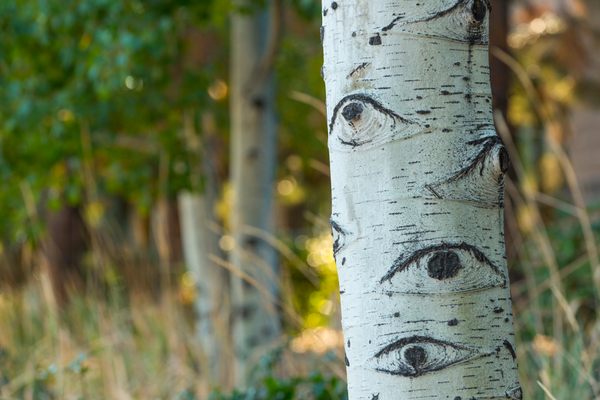An Animated Guide to Nature’s Best Wayfinding Secrets
Learn to navigate with the moon, stars, trees, and more.
Tristan Gooley is an expert at what he calls “natural navigation.” In a series of fascinating books, most recently How to Read Nature, The Nature Instinct, and How to Read Water, but also The Lost Art of Reading Nature’s Signs and The Natural Navigator: The Rediscovered Art of Letting Nature Be Your Guide, he shares incredibly useful tips and insights aimed at helping people notice simple truths about the world around them. Gooley’s particular genius is that once he shows you something about nature that you didn’t realize before, you’ll never be able to not see it again.
Recently, we sat down with Gooley and asked him to share five of his favorite natural navigation tricks with Atlas Obscura readers. The illustrator Chelsea Beck then took Gooley’s concepts and created gorgeous animations for each one. The words that accompany them are Gooley’s.

1. You can use the crescent moon to find south (or north)
The next time you see a crescent moon, draw a line that joins the horns together in a tangent, and then extend that line until it touches the horizon. In the northern parts of the world, at the bottom of the line, you’ll be looking roughly south.
This method isn’t perfect, but it gives you a very fast, rough-and-ready measure. The higher the crescent moon is, the more dependable the method is, so if the moon is just about to set or it’s just risen, it won’t be quite as good. But as a very fast, very simple check on which direction you’re facing, it’s one of the best.
Some people are curious why this works. It’s because the sun and the moon rise in the east and set in the west, broadly speaking. So they’re moving in an east-west plane, which means when they’re not in the same part of the sky, what we call a New Moon, they’re either east or west of each other. We know the moon doesn’t have any light of its own, so when we see the bright side of the moon, what it’s effectively doing is pointing at the sun. So when we join the dots, what we’re really saying is it must be pointing east or west, we don’t necessarily know which one, but if we draw the tangent line, we know that’s 90 degrees to an east-west line, so it has to be a north-south line. And where it touches your horizon has to be either north or south—note that if you’re in the Southern Hemisphere, then the line would actually point you to the north.—T.G.

2. Paying attention to birds can help you predict the weather
An awareness of wind direction is a very important part of natural navigation. It’s often one of the last useful clues left when all others have deserted us.
The next time you’re walking through your neighborhood, keep an eye out for groupings of birds perched high up, say on the apex of a roof or on telephone pole wires. If you notice that they’re all mostly facing one way, there’s a pretty strong chance they’re facing into the wind. Why would that be? Well if you think of aircraft, they always take off into wind, that’s just basic aerodynamics. So it’s the most sensible direction for a bird to be facing, all else being equal, in case they have to take off suddenly. It’s their equivalent of being on the runway ready to go.
Now try checking in with the group of birds in your chosen location regularly, say three or four times a day. If you suddenly notice that they’re all facing a slightly different way, they’re telling us that the direction of the wind is changing. And a significant shift in wind direction is a very strong indicator that the weather is about to change.
The thing to keep in mind with birds, like all animals and indeed people, is that individuals might do anything. So if you see an individual bird doing something, it might be interesting, it might be worth watching. But if you see a whole load of birds behaving in a certain way, then that’s a pattern.—T.G.

3. Most trees grow in a check mark shape
Obviously, all green plants need sunlight. So it’s logical that plants will, all things being equal, tend to grow more abundantly on the side the light comes from. In the northern parts of the world, where the sun is due south in the middle of the day, that means plants are growing more abundantly on the south side.
Try noticing this in a tree the next time you take a walk outside. You should see that there’s more tree on the south side, unless there are other factors—for instance there are amazing examples of glass buildings that can make trees grow the wrong way. But generally speaking, there should be more of the tree on the south side.
Next, take this one step further. Because of a botanical effect called phototropism, all the branches on a tree are trying to grow toward the light. On the south side, they can take a fairly direct route. So they curve toward the sun, which creates a slightly more horizontal branch. On the north side, they’re still trying to grow toward the light, but they can’t take a direct route because the trunk and the rest of the tree are in the way. So they end up growing towards the sky. This is how you end up with what I call the “check effect,” which is especially noticeable in trees. Together, the whole shape looks like a check mark.—T.G.
-4ad52628-99f9-4fff-b328-1c2ffef4df25.webp)
4. At a T junction, you can usually tell which way to turn
Let’s say you’re out hiking, and you’ve lost confidence in your route. If you come to a T junction, you may even panic a bit: Which way should you turn? But the thing is, you’re very likely to be able to notice which way most people have turned here over time. More often than not, there’s a strong trend.
You might think it’s a 50-50 decision, but in fact it’s quite rare for the attractions in both directions to be equally strong. There’s nearly always a slightly bigger town, or even just a café that’s very popular—some reason why people turn one way more often than the other. The classic shape you get, for example, is when a bit of corner cutting goes on, so if there’s grass where you are, you end up with the grass suffering in that corner of the T junction.
With practice, you’ll start to see this in almost all environments. Even with a paved sidewalk, if you get your eyes low with low light, you’ll notice a little bit of shine and various other clues. It works absolutely everywhere. If you’re lost in the woods, or anywhere there’s a path network, there’s a temptation when you reach a crossroads to go, “Oh God, I don’t know which way to go.” But it’s nearly always a gift, because on average, if you turn the way most people have already turned, you’re nearly always going to be heading toward civilization.—T.G.

5. You can use Cassiopeia to find the North Star
To use Cassiopeia to find direction, we’re going to try to use it to find the North Star. Why are we trying to find the North Star? As its name suggests, the North Star is due north (technically, it’s within one degree of due north). If you can identify the North Star, you can draw a vertical line down to the ground, and you’ll be looking north.
There are lots of different ways to find the North Star, but Cassiopeia is one of the fun ones. So how do we find it? You’re looking for five stars that are in the rough shape of a W. It’s not a perfect W—it’s a little stretched on one side and little squished on the other side, but it is quite a recognizable shape. Over the course of the year, Cassiopeia wheels anti-clockwise around the North Star.
So to start, look for a constellation in the shape of a W. Keep in mind that as it wheels around, depending on the time of year, you might see it on its side, or as an M—but if you think of it as a W you’ll always be able to orient this trick correctly. Once you’ve found the W, imagine laying a tray, just a flat tray, across the top of the W. Next, wheel that tray roughly 90 degrees anti-clockwise, so it’s pointing away from the W. Then, double the distance of the tray. Start looking in that part of the night sky, and you’ll find a star. That’s the North Star. This will work anywhere in the Northern Hemisphere.
One of the things about the North Star is if people aren’t familiar with it, they tend to think of it as the brightest star in the night sky. But in fact, the North Star isn’t all that bright—it’s going to appear the same level of brightness as the stars in the W of Cassiopeia. But, what the North Star does have going for it is it’s on its own. You won’t see anything of comparative brightness in that part of the sky. And this trick doesn’t point perfectly at it: what this does is get you to the part of the night sky where the North Star is, a rough little target of where to look. If you find yourself looking at two or more stars close to each other, that’s one way to tell that you are definitely not looking at the North Star.—T.G.
* This article was updated on June 22, 2020, to include mention of two additional books by Tristan Gooley. Check out Gooley’s full Natural Navigation book series.


















Follow us on Twitter to get the latest on the world's hidden wonders.
Like us on Facebook to get the latest on the world's hidden wonders.
Follow us on Twitter Like us on Facebook